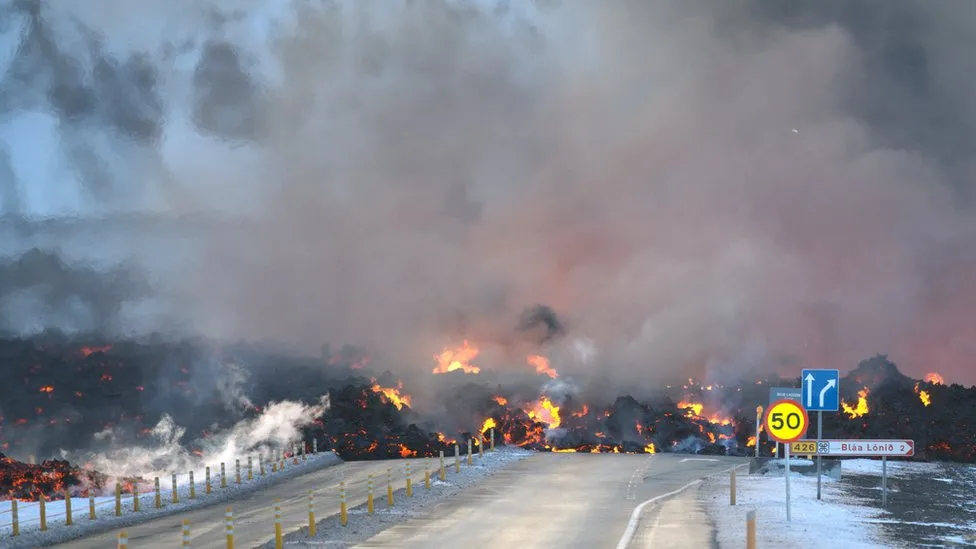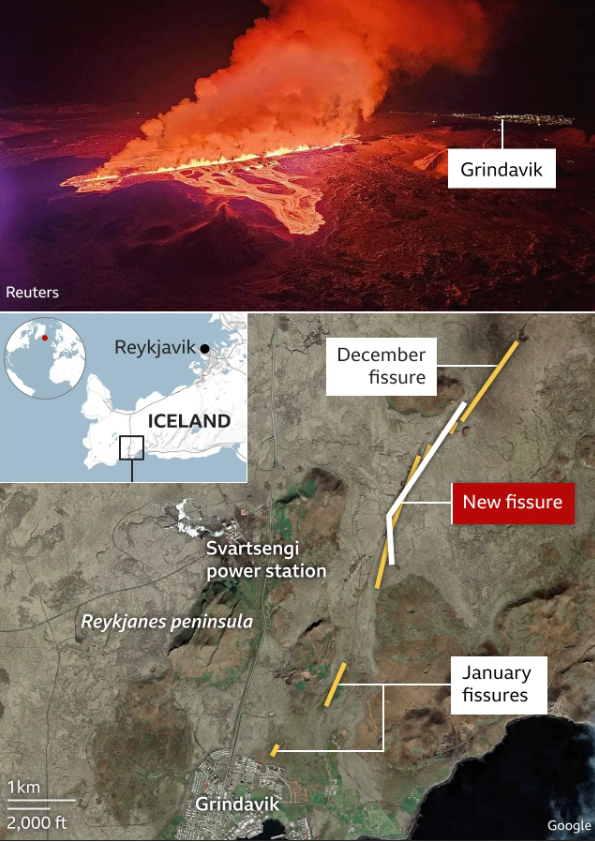
Iceland was greeted this week with another day of fiery events, as immense streams of molten rock illuminated the dim morning atmosphere.
Grindavik, the town evacuated during this incident, was fortunate to be untouched. However, the flowing lava caused significant damage by covering a pipe that supplies heat and hot water to many residents in the vicinity. Additionally, it blocked access to the Blue Lagoon, a popular tourist spot.
Recent Volcanic Activity in Iceland
Since December 2023, there have been three brief volcanic eruptions in the Reykjanes peninsula, marking a total of six eruptions since 2021. However, experts anticipate that this is merely the beginning of a prolonged period of volcanic activity that may persist for several decades or potentially even centuries.
So what is going on?
Iceland is quite familiar with volcanoes as it is among the most active volcanic regions globally.

This is due to the country’s location above a geological hotspot, where hot material from the depths of the Earth moves upward towards the surface.
However, Iceland is located at the intersection of the Eurasian and North America tectonic plates. These plates are gradually moving apart, resulting in the formation of a gap where hot molten rock, known as magma, can rise to the surface.
As the molten rock accumulates beneath the Earth’s surface, the force exerted continues to rise until it breaches the top layer, resulting in an eruption (referred to as lava when it reaches the surface).
Iceland has over 100 volcanoes, with over 30 currently in an active state.
The Reykjanes peninsula has not witnessed any lava flow in many centuries, potentially beginning as early as the 8th or 9th Century and lasting until 1240.
The eruptions have resumed once more, but what is the reason behind the 800-year pause?
Prof Tamsin Mather, an Earth scientist from the University of Oxford, states that over a long period of time, the tectonic plates are separating at a rate similar to the growth of fingernails, which amounts to a few centimetres per year.
“However, instead of separating seamlessly, they undergo intermittent bursts of heightened activity. It is probable that this is the phenomenon currently observed in the Reykjanes area.”
The Potential Impacts of a New Volcanic Era
The rocks found in this area hold further information about the past, indicating a consistent occurrence of peaceful periods lasting approximately 1,000 years followed by volcanic eruptions that persist for a few centuries.

Professor Mather explains that there is evidence of approximately three occurrences of these types of events in the past 4,000 years in this particular region.
At present, the situation is progressing as anticipated. We anticipate a succession of these relatively minor eruptions that will occur intermittently in the years and decades ahead.
Iceland’s current focus is determining how to forecast the timing of volcanic eruptions, which is particularly crucial due to the proximity of the town of Grindavik and a vital geothermal power plant that form an essential part of the nation’s infrastructure and are at risk.
Dr. Evgenia Ilyinskaya, a volcanologist from the University of Leeds, says that with the repetitive eruptions occurring, scientists now have a clearer understanding of the situation.
Thus, they have been monitoring the gradual inflation of the ground caused by the emergence of magma from deep within. Currently, they are able to predict with much greater accuracy the specific timeframe when the magma will rupture through the surface.
However, determining the specific location of a volcanic eruption is more challenging. Unlike cone-shaped volcanoes such as Mount Etna in Italy, which consistently release lava from a single point, these volcanoes do not have a predictable eruption site.

In the Reykjanes Peninsula, the magma is not tightly confined and instead covers a wider area. As a result, it bursts out through lengthy cracks known as fissures.
The town and power station in Iceland are being protected by the construction of substantial barriers, which are effective in preventing the lava from advancing.
However, if a crack appears within the protective structures – like what happened in Grindavik earlier this year resulting in the destruction of several houses – there is little that can be accomplished.
Iceland will experience significant consequences as a result of a prolonged series of volcanic eruptions.
According to Dr Ilyinskaya, this area in Iceland has the highest population density, with around 70% of the people residing within a radius of approximately 40km.
“All the essential facilities are present, including the primary international airport, large geothermal power stations, and a considerable amount of tourist amenities as well, which significantly contributes to Iceland’s economy.”
There are various risks associated with the lava flow and air pollution caused by the eruptions, such as the disruption of important roads.
According to Dr. Ilyinskaya, Reykjavik, the capital of the country, also has the possibility of being affected.
Also Read: Bioxyne’s CanxChange platform brings transparency to Australia’s B2B medical cannabis market
Iceland’s Preparations for a New Volcanic Era
If the eruptions in Iceland’s capital, Reykjavik, move to the east along the peninsula, it could be dangerous. This is because there are lava flows from 1,000 years ago that are currently located in Reykjavik. Therefore, it is possible that future eruptions could also cause the lava to flow into Reykjavik.

Is there a method to anticipate future occurrences on a prolonged timeframe?
Researchers are investigating a variety of volcano complexes located throughout the peninsula.
Dr. Dave McGarvie from Lancaster University explains that during the previous cycle, the initial eruptions occurred in the eastern systems and then gradually moved westward. However, there were occasional interruptions and irregularities in this movement.
In the current occurrence, the initial volcanic activities occurred in 2021 within a region located closer to the central area of the peninsula.
Currently, the system appears to have completely shut down – there are no obvious signs of molten rock accumulating below it. It is unclear whether this is a temporary situation or if it will persist indefinitely, potentially resulting in no future volcanic activity during this cycle.
The latest volcanic activity, which started in December, is currently occurring in a nearby region slightly westward.
Dr. McGarvie explains that scientists can estimate the amount of magma stored underground and determine the likelihood of it moving from Grindavik and the power station to another nearby volcanic system.
If they observed a decrease in the rate at which magma is flowing in, it could suggest that it is beginning to shut down. If that is the case, it might take a few months before it fully subsides.
The issue at hand is whether this is just a short pause or if it signifies the conclusion of this particular period of action. At this stage, we are navigating through uncharted territory.
As Iceland enters a new era of volcanic activity, scientists are gaining increased knowledge from each eruption. However, there remains a significant amount of uncertainty for the country.
